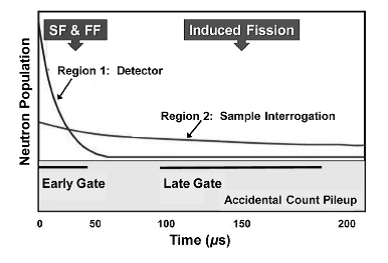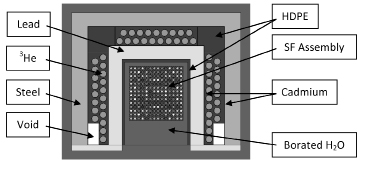
Figure
26. Neutron capture time distributions from spontaneous and induced
fission events.
The DDSI system exploits a very slight difference in the arrival
time of neutrons from spontaneous fission in spent fuel Curium and
neutrons from induced fission in spent fuel fissile material. The
primary source of neutrons from spent fuel is from spontaneous
fission (SF) in Cm-244. The SF neutrons arrive at system He-3
neutron detectors, experience one thermalization (slow to thermal
neutron speeds), and are absorbed in the detector. Induced
fission neutrons from spent fuel fissile material absorbed in the
system detectors are the result of two neutron
thermalizations. First an SF neutron must be thermalized and
absorbed in spent fuel fissile material to produce a fissile
material fission neutron. Then the fissile material fission
neutron must be thermalized and absorbed in the detector.
By setting an early gate and a late gate for neutron detector
counts DDSI can distinguish between SF neutrons, which dominate the
early gate, and self-interrogation fission neutron, which dominate
the late gate. Figure 26 illustrates this difference.
The fission neutron count rate can then be correlated to the amount
of fissile material in the fuel. Figure 27 shows a
cross-sectional view of the DDSI with He-3 tubes in a fork-like
block of high density polyethylene (HDPE). The HDPE is lined
with cadmium, and the whole apparatus is surrounded by lead to
shield the detectors from the intense gamma radiation of the spent
fuel.

Figure
27. Cross-sectional view of the DDSI design
Source: A. Belian, H.O. Menlove, M.T. Swinhoe, and S.J. Tobin,
"New Design of the Differential Die-away Self-interrogation
Instrument for Spent Fuel Assay," Journal of Nuclear
Materials Management 40:3 (2012).